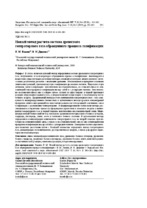Новый метод расчета состава древесного генераторного газа обращенного процесса газификации

Date
2019Publisher
Another Title
The New Method for Determining the Composition of Wood Gas Produced in Gas Generators of the Inverted Gasification Process
Bibliographic entry
Кашин, Е. М. Новый метод расчета состава древесного генераторного газа обращенного процесса газификации = The New Method for Determining the Composition of Wood Gas Produced in Gas Generators of the Inverted Gasification Process / Е. М. Кашин, В. Н. Диденко // Энергетика. Известия высших учебных заведений и энергетических объединений СНГ. – 2019. – № 4. – С. 341-361.
Abstract
В статье излагается новый метод определения состава древесного генераторного газа, получаемого в газогенераторах обращенного процесса газификации. Анализируются недостатки существующих расчетных методов, главным из которых является плохое согласование результатов расчетов с опытными данными. Обосновывается приоритет основных химических реакций, протекающих при газификации древесного топлива. Выделяются три активные зоны газификации: окислительно-восстановительная, восстановительная и зона взаимодействия продуктов газификации между собой и с углеродом топлива. Окислительно-восстановительная зона в общем случае состоит из двух подзон: в первой протекают реакции образования водяного газа, а вторая появляется при подаче в газогенератор избыточного воздуха. Предлагаемый метод расчета компонентов генераторного газа – это совокупность модифицированного балансового и добавленного методов расчета концентраций продуктов химических реакций по константам равновесия этих реакций в активных зонах газификации с различными температурами. В модифицированном балансовом методе рассматриваются первичные процессы превращения древесины и влажного воздуха в компоненты генераторного газа в первой подзоне окислительно-восстановительной зоны. Модифицированный балансовый метод основан на уравнениях материального баланса углерода, водорода, кислорода, влаги, азота и теплового баланса системы. В добавленном методе определяются концентрации компонентов генераторного газа во второй подзоне окислительно-восстановительной зоны, а также в восстановительной зоне и зоне взаимодействия продуктов газификации между собой и с углеродом топлива. Совокупность этих двух методов позволяет расчетным путем с большой точностью определять выход генераторного газа, концентрации его компонентов, расход топлива и воздуха, а также ряд других характеристик газогенератора.
Abstract in another language
The article presents a new method for determining the composition of wood generator gas produced in gas generators of the inverted gasification process. The shortcomings of the existing calculation methods are analyzed, the main of which is the insufficient harmonization of the calculation results with the experimental data. The authors substantiate the priority of the main chemical reactions occurring during gasification of wood fuel. There are three active zones of gasification, viz.: a redox zone, a reduction zone and a zone of interaction of gasification products with each other and with the carbon of the fuel. In general, a redox zone consists of two subzones: in the first one reactions of water gas formation occur, and the second one appears when excess air is supplied to the gas generator. The proposed method for calculating the components of the generator gas is a set of a modified balance method and an added method for calculating the concentrations of chemical reaction products by the equilibrium constants of these reactions in the active gasification zones with different temperatures. The modified balance method considers the primary processes of wood and moist air transformation into components of the generator gas in the first subzone of the redox zone. The modified balance method is based on the equations of material balance of carbon, hydrogen, oxygen, moisture, nitrogen and thermal balance of the system. The added method determines the concentrations of the components of the generator gas in the second subzone of the redox zone, as well as in the reduction zone and the zone of interaction of the gasification products with each other and with the fuel carbon. The combination of these two methods makes it possible to calculate with greater accuracy the output of the generator gas, the concentration of its components, fuel and air consumption, as well as a number of other characteristics of the gas generator.
View/
Collections
- № 4[6]
